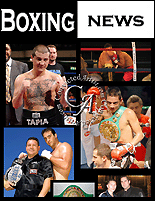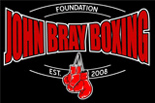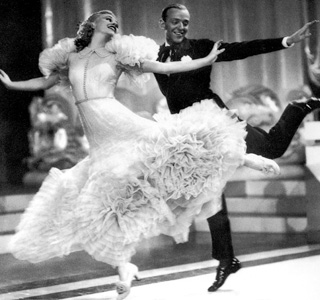 A perfect match-up of two fighters is a lot like watching Fred Astaire and Ginger Rogers. When styles mesh, there’s a fluidity and beauty to the action that brings boxing to the level of improvised performance art. These are the rare instances where lunges, parries, punches, blocks, feints and clinches create an ebb and flow that seems almost choreographed - bouts where the momentum moves us along to a crescendo and dénouement with scarcely a wasted movement or clinch.
A perfect match-up of two fighters is a lot like watching Fred Astaire and Ginger Rogers. When styles mesh, there’s a fluidity and beauty to the action that brings boxing to the level of improvised performance art. These are the rare instances where lunges, parries, punches, blocks, feints and clinches create an ebb and flow that seems almost choreographed - bouts where the momentum moves us along to a crescendo and dénouement with scarcely a wasted movement or clinch.
Interestingly, classic boxers with outstanding footwork are sometimes lousy dance partners. Slick 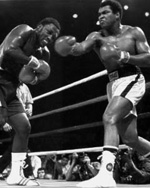 movers like Floyd Mayweather, Pernell Whitaker, Roy Jones, and Bernard Hopkins have tendencies to run or clinch to the point where the flow of the fight is more like a log-jam than a waterfall.
movers like Floyd Mayweather, Pernell Whitaker, Roy Jones, and Bernard Hopkins have tendencies to run or clinch to the point where the flow of the fight is more like a log-jam than a waterfall.
A matchup of sluggers occasionally creates more intrinsic beauty than a pairing of standup boxers. One thinks of Duran versus De Jesus, Hagler versus Mugabi, Foreman versus Lyle, and Trinidad versus Mayorga. All were grueling, fast-paced fights with both boxers looking for KO’s, and yet they were exquisite in their symmetry. 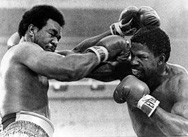 The old axiom, “styles make fights,” describes one of the most enigmatic traits of boxing. However, it needs a clarifying addendum: “Styles make fights, and minute discrepancies create contradictory outcomes.” No matter how astutely pundits dissect the fighters’ skill sets and compare opponents, it’s relatively meaningless until that moment when the two come together inside the ring. The wild card that signifies consternation for odds-makers is the variable that stirs fans to continue coughing up exorbitant sums to see a fight. They are compelled by the outside chance that what appears to be a mismatch on paper may become a shocker in the flesh.
The old axiom, “styles make fights,” describes one of the most enigmatic traits of boxing. However, it needs a clarifying addendum: “Styles make fights, and minute discrepancies create contradictory outcomes.” No matter how astutely pundits dissect the fighters’ skill sets and compare opponents, it’s relatively meaningless until that moment when the two come together inside the ring. The wild card that signifies consternation for odds-makers is the variable that stirs fans to continue coughing up exorbitant sums to see a fight. They are compelled by the outside chance that what appears to be a mismatch on paper may become a shocker in the flesh.
It took Felix Trinidad to tarnish “The Golden Boy,” Hopkins to solve Trinidad, and Vernon Forrest to disrupt Shane Mosely’s nine-year winning streak in two shocking upsets. Forrest had Mosely’s number, and the perfect style to take the championship he later lost to Ricardo Mayorga by third round KO, yet MosIey KO’d Mayorga five years later.
It took Joe Frazier to derail Ali, Foreman to trounce Frazier, and Ali to demystify Foreman. It took Marco Antonio Barrera to capitalize on Prince Naseem Hamed’s egregious technical flaws, Douglas to upset Tyson, Holyfield to overwhelm Douglas, Bowe to befuddle Holyfield, Tarver to unstitch Roy Jones, and on it goes …
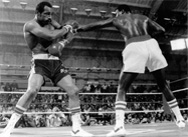 I was recently watching the 1978 Holmes –Norton fight for the umpteenth time. The 15th round of this bout is one of the greatest in the annals of Heavyweight Championship Boxing. Even though the fight ended in a split decision, Ken Norton - who gave Ali nothing but trouble over three bouts - was easily out-pointed, out-boxed and occasionally out-gunned by the 27-year-old Larry Holmes. This was shocking to many, because Holmes - a former sparring partner for Ali - was ridiculed for being an Ali clone. But Norton was never really in the running, even though the judges scored it a close fight.
I was recently watching the 1978 Holmes –Norton fight for the umpteenth time. The 15th round of this bout is one of the greatest in the annals of Heavyweight Championship Boxing. Even though the fight ended in a split decision, Ken Norton - who gave Ali nothing but trouble over three bouts - was easily out-pointed, out-boxed and occasionally out-gunned by the 27-year-old Larry Holmes. This was shocking to many, because Holmes - a former sparring partner for Ali - was ridiculed for being an Ali clone. But Norton was never really in the running, even though the judges scored it a close fight.
What made the difference? Holmes was so similar to Ali that it should have been a walkover for Norton. What did Holmes do that “The Greatest” could not?
During most of his career, Ali used his jab as a flicking rangefinder more than a solid offensive punch. He sometimes delivered the jab with an open glove that was little more than a slap. While it was successful at keeping his opponents off balance, it didn’t keep them from backing him into the ropes once his legs gave out. The “Rope-a-Dope” which served Ali so well against George Foreman - a straight-up slugger who threw wide punches - was ineffective against Norton whose awkward, crab-like stance allowed him to punch around Ali’s gloves while ducking inside the jab.
Holmes, on the other hand, leaned into his jab, making it a far more punishing weapon. Norton had to pay a price as he attempted to walk through it, and was forced to fight on the outside. This allowed Holmes to pick Norton apart while he circled, like Indians around a Wagon Train. And dance …? Boy, did Larry Holmes dance that night. His lateral movement was constant throughout, as he changed directions without a hitch. That movement was essential to his victory. 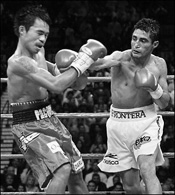 While examples of unlikely outcomes are rampant, the 1980’s featured one of the most outstanding series of contrasting results I can remember: Hearns looks invincible against Cuevas, Leonard stops Hearns, Duran beats Leonard, Hearns suckers Duran with a one-two punch, Hagler KO’s Hearns, Barkley KO’s Hearns, Duran pulverizes Barkley and Moore, Duran gives Hagler all he can handle, Hagler KO’s undefeated slugger John Mugabi, Leonard takes Hagler’s title, Hearns drops Leonard twice in their rematch, and Leonard confuses Duran for the second time. Whew!
While examples of unlikely outcomes are rampant, the 1980’s featured one of the most outstanding series of contrasting results I can remember: Hearns looks invincible against Cuevas, Leonard stops Hearns, Duran beats Leonard, Hearns suckers Duran with a one-two punch, Hagler KO’s Hearns, Barkley KO’s Hearns, Duran pulverizes Barkley and Moore, Duran gives Hagler all he can handle, Hagler KO’s undefeated slugger John Mugabi, Leonard takes Hagler’s title, Hearns drops Leonard twice in their rematch, and Leonard confuses Duran for the second time. Whew!
And so, looking at the great fighters of today, one wonders who will bring the goods to subdue whirlwinds like Manny Pacquiao and Flloyd Mayweather. There is undoubtedly somebody out there with the right dance steps, but it’s anybody’s guess who it will be.
Charles Long
www.convictedartist.com
Shall we dance? A perfect match-up of two fighters is a lot like watching Fred Astaire and Ginger Rogers
Related Articles:

Alex Ramos
Ashe Bowman
Austin Trout
Brandon Randon
Brian Minto
Caleb Truax
Chris Arreola
Courtney Gains
Cung Le
Danny Batchelder
Danny Jacobs
David Rodriguez
Dominick Guinn
Donnell Holmes
Gerald Washington
Glen Johnson
Ishe Smith
Isreal Vazquez
Johnny Bos
John Bray
John Scully
Lamon Brewster
Lisa McClellan
Joe Salazar
Joe Boxer Valenzuela
Kathy Long
Kaliesha West
Lamon Brewster
Johnny Tapia
Manuel Quezada
Miguel Espino
Peter Quillin
Robert Guerrero
Ross Puritty
Seth Petruzelli
Shawn Porter
Travis Walker
Victor Joe Boxer Valenzuela
Vivian Harris
Wahacanka Wilch





